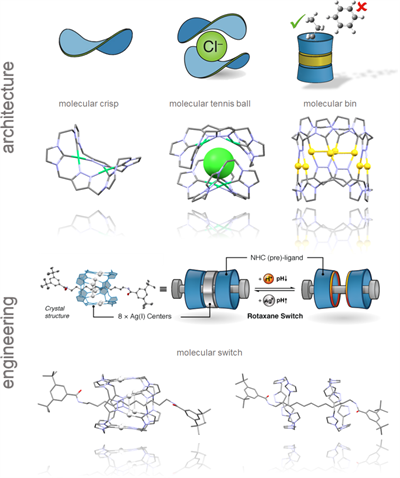Molecular architecture and engineering – Nano-scale craftsmanship using organometallic chemistry
- Location
- B01, Civil and Mechanical Engineering
- Dates
- Friday 20 April 2018 (12:00-13:00)
SPEAKER: Dr Alexander Pöthig, Catalysis Research Center, Technical University of Munich, IAS Vanguard Fellow
Figure 1. Differently shaped organometallocavitands and use in a pH-dependent molecular switch.

The development of innovative functional materials, that can help to tackle a variety of challenges, including environmental and medicinal problems, is a central aim of synthetically oriented chemists. The range of desired applications hereby is large: There is a need of materials that can efficiently reduce energy consumption (catalysts), store or refine fuels (gas storage & separation material), or in the medicinal context can be employed for diagnostics (contrast agents) or therapeutics (drugs, drug delivery).
Porous materials have been applied for some of these purposes quite some time, especially for separation and storage applications. One approach to design new materials towards desired properties is to build up multi-dimensional frameworks out of organic building blocks. These are connected either covalently (COFs) or via metal nodes (MOFs). Additionally, also discreet molecules with cavities – so-called cavitands – can be used as single pores for a variety of applications. However, in contrast to their rather projectable topology, the (post-synthetical) inclusion of further functionality into these materials is often difficult.
To overcome these limitations we design and employ organometallic complexes, which exhibit defined cavities and additionally possess intrinsic functionality, e.g. photoluminescence, selective guest recognition, easily adjustable polarity/solubility and catalytic activity.1-3 Furthermore, the complexes can be employed as building blocks in mechanically-interlocked molecules, namely rotaxanes, forming a pH-responsive molecular switch.4 In the talk, the synthesis, structural characterisation and functional properties of these novel organometallic architectures are presented and current as well as envisioned future applications are discussed.
Dr. Alexander Pöthig is an outstanding early-career researcher. He has published 116 original research papers and his h-index is 15, extraordinary only five years after his PhD. Alex has been developing large chemical agents with defined cavities. A highly interesting subclass of supramolecular host compounds are the so-called “pillarplexes” and the visit will allow cross-disciplinary exploration in this fascinating research area.
______________
1 P. J. Altmann, C. Jandl, A. Pöthig, Dalton Trans., 2015, 44, 11278-11281.
2 P. J. Altmann, A. Pöthig, Chem. Commun., 2016, 52, 9089-9092.
3 P. J. Altmann, A. Pöthig, J. Am. Chem. Soc., 2016, 138(40),13171–13174.
4 P. J. Altmann, A. Pöthig, Angew. Chem., Int. Ed. 2017, 129(49), 15939–15942.